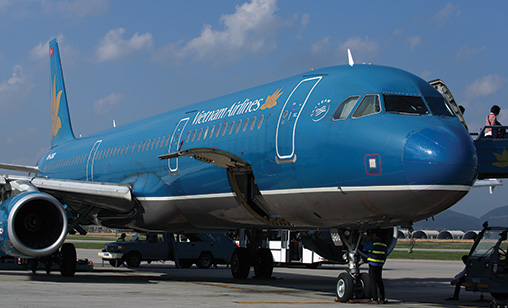News Backgrounder
Vietnam’s airports overwhelmed by explosive growth
October 1st 2019
With eight Vietnamese airlines holding air operator certificates and three more hopefuls applying to fly, the country’s air travel boom is exerting unprecedented pressure on the country’s aviation system. Read More »
Applications from the newcomers – Vinpearl Air, Vietravel Airlines and KiteAir – also are pending.
 |
The Civil Aviation Authority of Vietnam (CAAV) said overcrowded Tan Son Nhat International Airport, which serves Ho Chi Minh City (HCMC), and Hanoi’s Noi Bai, Da Nang and Nha Trang airports are facing capacity crunches.
The major domestic route, Hanoi to HCMC, served by Vietnam Airlines, Jetstar Pacific and Vietjet Air, accounts for 22.7% of air ticket sales. Ninety per cent of all flights are full, the CAAV said.
As a result, terminals and runways at Hanoi’s Noi Bai and HCMC have been operating above capacity for some time. Complicating matters is a shortage of trained staff, including air traffic controllers.
Adding to operational strains is the poaching of MRO engineers and pilots between competitors, a widespread practice that has forced government intervention. In a recent meeting about aviation issues, deputy prime minister, Trương Hòa Bình, was reported to have requested airlines to maintain a fair playing field to ensure their employees, including pilots, were not overworked because of understaffing.
Vietnam state media has said the staffing situation is so serious that the CAAV is curbing the delivery of new aircraft to the country’s airlines, including placing short-term curbs on new entrants’ fleet plans because there are not enough air traffic controllers to safely monitor the country’s expanding airline network.
The registered airlines flying in Vietnam are state-owned Vietnam Airlines, joint venture Jetstar Pacific, Air Mekong, VASCO, Indochina Airlines, VietJet, Viet Star Airlines and Bamboo Airlines.
Vinpearl Air plans to operate six aircraft from next July and bring in 30 more by mid next decade. Vietravel Airlines is hoping to commence operations in October 2020 with three aircraft and expand to a fleet of eight by 2025. KiteAir, a turbo prop operator that has said it will launch services with six ATR72s in the first quarter of next year aims to operate 15 ATR72 and 12 A320/A321 family planes by December 2024.
Pressure in domestic skies has prompted existing airlines to look overseas for expansion. In Vietjet’s interim half, its international passengers increased by 35%, to four million a year. Income from international routes outweighed domestic income for the first time, at 54% of revenue.
By 2030, the CAAV forecast, there will be 600 aircraft operating in Vietnam, three times as many as now. At June this year, the Vietnamese airline fleet was 197, an increase of 30% over 2018. Flag carrier, Vietnam Airlines, operated 95 aircraft and employed 1,135 pilots, of which 860 were Vietnamese, last year. It has a policy of Vietnamese first when recruiting staff.
| Hong Kong Airport upbeat on future despite city’s civil unrest At press time, Hong Kong International Airport (HKIA) was suffering from a slowdown in traffic as civil unrest continued into its fourth month in the Special Administrative Region (SAR) of China. But the protests were not putting the brakes HKIA’s expansion or its long-term growth forecast, the company’s general manager for airport and industry collaboration, Michael Y.K.Yuen, told delegates at a September global airports conference. In August, protestors’ intemperate occupation of airport check-in and arrival halls forced cancellation of close to 1,000 flights in one long weekend during the peak summer holiday season. But Yuen said HKIA’s $18 billion expansion plans are on track for a soft opening of the airport’s third runway early in the next decade as well as revamped terminals, construction of a vast shopping complex adjacent to the airport and other facilities scheduled for completion by 2024. Traffic at the airport slumped by 12.5% year-on-year in August, the largest decline in nine years. Yuen said the September figures will record another drop in traffic although “it will not be as severe as in August”, he said. The third runway is due to open in 2022, but there will not be a significant immediate jump in HKIA air movements because the airport’s two existing runways will be closed for renovation. All three runways are scheduled for full operation in 2024. From then, available slots will jump from 68 per hour to 102. Yuen said the airport will be able to take full advantage of the seven million people living in Hong Kong and tap into the 70 million population of the Greater Pearl River Delta. Mainland China passengers can check in, including their luggage, for their Hong Kong flights at numerous points on the Mainland before travelling by ferry or the new Hong Kong-Zhuhai-Macau bridge to HKIA. |